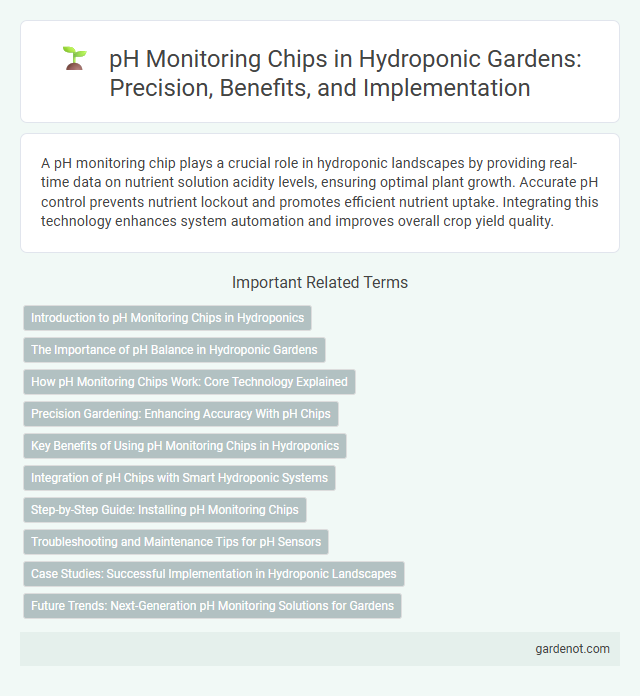A pH monitoring chip plays a crucial role in hydroponic landscapes by providing real-time data on nutrient solution acidity levels, ensuring optimal plant growth. Accurate pH control prevents nutrient lockout and promotes efficient nutrient uptake. Integrating this technology enhances system automation and improves overall crop yield quality.
Introduction to pH Monitoring Chips in Hydroponics
pH monitoring chips in hydroponics play a crucial role in maintaining optimal nutrient absorption by accurately measuring the acidity or alkalinity of the nutrient solution. These semiconductor-based sensors provide real-time data, enabling precise adjustments to the pH levels, which typically range from 5.5 to 6.5 for most hydroponic crops. Implementing pH monitoring chips enhances plant health and maximizes growth efficiency by ensuring the nutrient solution remains within ideal parameters.
The Importance of pH Balance in Hydroponic Gardens
Maintaining optimal pH balance between 5.5 and 6.5 is crucial for nutrient absorption in hydroponic gardens, directly impacting plant growth and yield. A pH monitoring chip provides real-time, accurate measurements enabling growers to adjust nutrient solutions promptly and prevent nutrient lockout or toxicity. Continuous pH monitoring helps sustain a stable environment, promoting healthier roots and maximizing crop production in hydroponic systems.
How pH Monitoring Chips Work: Core Technology Explained
pH monitoring chips use ion-sensitive field-effect transistors (ISFETs) to detect hydrogen ion concentration in hydroponic nutrient solutions, providing real-time pH measurements essential for optimal plant growth. These chips translate chemical signals from the solution into electrical signals by measuring voltage changes caused by ion activity at the sensor surface. Integrated with IoT systems, pH monitoring chips enable precise control of hydroponic environments, ensuring nutrient availability and preventing imbalances that could hinder plant development.
Precision Gardening: Enhancing Accuracy With pH Chips
pH monitoring chips revolutionize hydroponic landscapes by providing precise, real-time data on nutrient solution acidity, essential for optimal plant growth and root health. These chips detect minute pH fluctuations with high sensitivity, enabling growers to maintain ideal conditions and prevent nutrient imbalances. Integrating pH sensors into hydroponic systems enhances precision gardening by automating adjustments, reducing manual errors, and improving crop yield consistency.
Key Benefits of Using pH Monitoring Chips in Hydroponics
pH monitoring chips provide precise and real-time data essential for maintaining optimal nutrient absorption in hydroponic systems. These chips enable continuous pH level tracking, preventing nutrient imbalances that could stunt plant growth or reduce yield. By utilizing advanced sensors, pH monitoring chips improve overall crop health and increase the efficiency of hydroponic nutrient management.
Integration of pH Chips with Smart Hydroponic Systems
Integration of pH monitoring chips in smart hydroponic systems enables precise nutrient management by continuously tracking the solution's acidity levels. These sensors transmit real-time pH data to automated control units, facilitating immediate adjustments to maintain optimal growth conditions. Enhanced accuracy and rapid response improve plant health and yield in hydroponic landscapes through seamless system automation.
Step-by-Step Guide: Installing pH Monitoring Chips
Installing pH monitoring chips in hydroponic landscapes ensures precise nutrient balance by continuously measuring solution acidity levels. Begin by calibrating the chip with standard buffer solutions, then securely attach it to the nutrient reservoir or root zone for accurate data collection. Regular maintenance includes cleaning the sensor surface and recalibrating every two weeks to maintain consistent performance and optimal plant growth conditions.
Troubleshooting and Maintenance Tips for pH Sensors
Regular calibration of pH monitoring chips using standard buffer solutions ensures accurate readings essential for optimal hydroponic landscape management. Cleaning the sensor with a mild detergent and rinsing it with distilled water prevents residue buildup that can cause faulty measurements. Replacing worn membranes or electrodes promptly maintains sensor responsiveness, reducing downtime and maintaining nutrient solution stability.
Case Studies: Successful Implementation in Hydroponic Landscapes
Case studies highlight the successful implementation of pH monitoring chips in hydroponic landscapes by demonstrating precise nutrient management and enhanced plant growth. Data from multiple hydroponic farms reveal that continuous pH tracking reduces nutrient imbalances, leading to a 20% increase in yield and improved crop quality. Integration of these sensors with automated dosing systems ensures optimal pH levels, minimizing resource waste and maximizing efficiency in controlled environment agriculture.
Future Trends: Next-Generation pH Monitoring Solutions for Gardens
Next-generation pH monitoring chips for hydroponic landscapes integrate advanced nanomaterials and AI-driven analytics to provide ultra-precise, real-time soil and nutrient solution readings. These innovative sensors enable automated adjustments to maintain optimal pH levels, enhancing plant health and maximizing growth efficiency. Future trends emphasize wireless connectivity and energy-harvesting capabilities, ensuring uninterrupted monitoring in smart garden ecosystems.
pH monitoring chip Infographic

 gardenot.com
gardenot.com